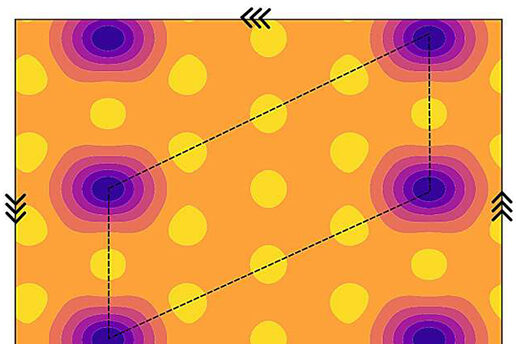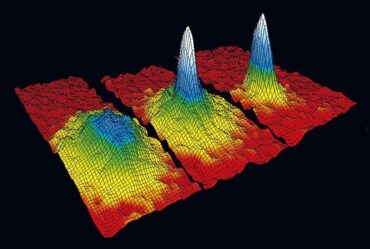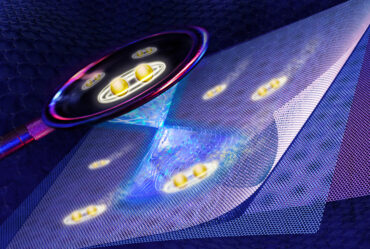
Study predicts a new quantum anomalous crystal in fractionally filled moiré superlattices
Moiré superlattices, structures that arise when two layers of two-dimensional (2D) materials are overlaid with a small twist angle, have been the focus of numerous physics studies. This is because they have recently been found to host novel fascinating unobserved physical phenomena and exotic phases of matter.
Researchers at California State University Northridge, Stockholm University and Massachusetts Institute of Technology (MIT) recently predicted the emergence of a new quantum anomalous state of matter in fractionally filled moiré superlattice bands. Their paper, published in Physical Review Letters, predicts the existence of this state of matter in the twisted semiconductor bilayer 𝑡MoTe2.
“Moiré materials host a variety of electron phases, including topological quantum liquids and electron crystals,” Liang Fu, co-author of the paper, told Phys.org. “Broadly speaking, crystallization and topology are rooted in an electron’s particle and wave aspect respectively.”
Inspired by recent studies focusing on moiré superlattices, Fu and his colleagues set out to explore the dual nature of electrons in these materials. After calculations and considerations, they predicted the emergence of a topological electron crystal in these materials that had never been observed before.
“Our primary objectives were to understand what new quantum phases can be realized, given the distinct characteristic features of moiré superlattice systems with a richer interplay between kinetic energy and interaction, as well as how to characterize them,” said Donna Sheng, co-author of the paper.
The new state of matter discovered by the research team exhibits an intriguing combination of intertwined ferromagnetism, charge order and topology. This combination of properties is highly unusual, as generally topology and local charge order compete and are not observed together.
“This class of states may be quite common in moiré superlattices, with telltale experimental signatures including a quantized and surprisingly large zero-field Hall conductance,” said Emil J. Bergholtz, co-author of the paper.
“What makes this even more remarkable is that strong Coulomb interactions drive this state. Without these interactions, the system would behave like a simple metal. However, the topology of the strongly interacting system is nevertheless manifested in terms of effectively non-interacting fermions in the form of a Chern insulating state.”
The team’s prediction of this new state of matter is grounded on extensive numerical calculations, using data from studies examining twisted bilayer semiconductors. The researchers also created a simple phenomenological model that captures the main qualitative features of the new state, offering a better understanding of its underlying physics.
“Our study identified a new and unexpected phase of matter that combines different aspects of quantum phenomena that arise in strongly interacting materials such as crystallization and topology,” said Ahmed Abouelkomsan, co-author of the paper.
“This phase is found to be competing with neighboring phases such as the composite fermi liquid phase that doesn’t exhibit crystallization. Our findings therefore serve as a guide to current experiments on moiré materials which try to identify the possible underlying phases.”
This recent study opens new possibilities for the study of exotic phases of matter in moiré superlattices. Recent studies gathered the experimental observation of a quantum anomalous Hall crystal in twisted bilayer–trilayer graphene, which closely resembles the state predicted by the team at California State University Northridge, Stockholm University and MIT.
In their next studies, Fu, Sheng and their colleagues plan to continue investigating the state of matter they predicted and hopefully unveil other exotic states in moiré superlattices. Based on their results, they predict that integer Chern insulator crystals at fractional moiré band filling play an important role in the phenomenology of moiré superlattices.
“Such states had been observed under a finite magnetic field prior to our work and have since been observed at zero field in several graphene-based moiré systems,” Aidan Reddy, co-author of the paper, said.
“This phenomenology raises many theoretical questions. For instance, how should we think about the energetic competition between these states and fractional Chern insulators? How should we understand the relationship of the crystal’s filling factor and Chern number to the Chern number of the underlying moiré bands?
“We are excited to continue thinking about these questions among others.”
More information: D. N. Sheng et al, Quantum Anomalous Hall Crystal at Fractional Filling of Moiré Superlattices, Physical Review Letters (2024). DOI: 10.1103/PhysRevLett.133.066601
Journal information: Physical Review Letters


